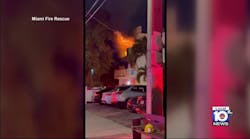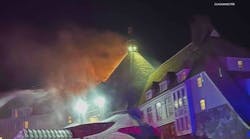As a mortar-type firework launched a burst of flame Tuesday in Belton, Austin Boerckel, 15, watched. It was the first day fireworks could legally be purchased and used there. Fireworks injure about 9,600 persons a year in the United States.
Conrad
Conrad Bonney of Kansas City spent 24 days in a hospital last year after his leg was burned in an accident involving a firework set off by a neighbor. The 12-year-old wont be going near fireworks this year.
Conrad Bonney wasnt too happy last July 4 when his parents wouldnt allow him to shoot off fireworks. Too dangerous, they said.
So they would only let the 11-year-old watch others shoot them off across the street. But as Conrad sat on the ground watching, a fireball from a fountain shot up the leg of his shorts. It lodged between his thighs, melting his boxers and burning his skin.
It was just a freak accident, but I dont want it to happen to anyone else, said the Kansas City youngster.
Conrad underwent four skin grafts and spent 24 days at Childrens Mercy Hospital, most of that time in the burn unit. His advice for other kids this Fourth of July: Stay away from fireworks. Far away.
Im trying to get the point out not to do them, he said, even though Im going to miss them.
Last year was particularly bad for fireworks injuries locally a 4-year-old Platte County girl died, and a woman and six children were burned when a bag of fireworks exploded in a sport-utility vehicle. Fireworks accidents nationally also have been on the rise recently, although they are lower than 1990s levels.
The good news is that the number of persons injured is not rising with the dramatic increase in the amount of fireworks purchased in the United States. Retail sales are at record levels, with Americans buying 212 million pounds of fireworks last year, or two pounds for every household.
Despite the recent rise in injuries, fireworks are being used more safely than they were 10 or 15 years ago, said Julie Heckman, executive director of the American Pyrotechnics Association, a leading trade group. Citing government statistics, Heckman said the number of persons injured by fireworks in a year has dropped 30 percent from its peak a decade ago.
Still, about 9,600 persons a year are injured by fireworks. Many victims are children. And some of those injuries are serious.
The Fourth of July is something that really gets us going because the injuries we see are so bad, said Denise Dowd, chief of injury prevention at Childrens Mercy Hospitals emergency department.
Last year the hospital treated 38 children for fireworks injuries during the holiday, compared with about 20 to 30 in an average year.
An analysis of Consumer Product Safety Commission data by The Kansas City Star found that:
Nearly half of those injured nationally are children under 15, and three-fourths of the injuries are to boys. The most-often injured group is boys 5 to 9 years old.
Parts of the body injured the most are the eye, face, hand and fingers.
Firecrackers are the number-one source of fireworks injury, followed by sparklers and bottle rockets.
The safety agency also has been tracking an increasing number of fireworks-related deaths: four each in 2001 and 2002; six in 2003 and eight last year. Of that nationwide total, two were in the Kansas City area the 4-year-old who died last year after being struck by a fireworks fragment, and a 33-year-old man who was killed by a mortar he was igniting in 2002.
Fireworks also cause all sorts of bizarre accidents.
Dig deep enough into Consumer Product Safety Commission data and youll find people knocked down stairs by fireworks. Or bumped off their bikes. And no fewer than a dozen persons have been hurt when frightened dogs wrapped their masters up in a leash and they fell.
Noise from the explosions can hurt you, too. Melanie Macko, an area audiologist, said four or five of her patients in the past six years have attributed their hearing loss to fireworks. In those cases, Macko said, the loss was permanent.
People like to be stupid and play a joke on someone by putting a firecracker too close to them, Macko said. That can be very dangerous.
Most hearing damage from fireworks is temporary. But a loud enough blast can destroy part of the inner ear that facilitates hearing. Children are especially vulnerable because their ear canals are smaller, Macko said.
But if youre looking for fireworks this Fourth of July, youre in the right place. Missouri is one of the top states for fireworks entrepreneurs both legal and illegal according to industry and government officials.
The National Fireworks Association even has its headquarters in this area. And northern Missouri is a hotbed of fireworks makers and wholesalers, said state fire marshal Randy Cole.
In fact, there are so many fireworks operations in Missouri, Cole said, that the number of illegal sales he stops each year depends mostly on how many investigators he can send into the field.
Well typically see four or five operations that deal illegal fireworks, he said. We do see more incidents than we would like to see concerning the sale and use of illegal fireworks.
In Kansas, the state fire marshals office said it relies mostly on local police to uncover illegal fireworks operations.
Even legal fireworks, however, pose risks. Many health advocates recommend keeping fireworks away from children and limiting viewing to the public displays put on by licensed professionals.
Although retail sales are booming, tight government regulations and tighter budgets have public fireworks display companies struggling financially this Fourth of July, industry officials said.
For the professional display side of the industry, its about survival right now, Heckman said. For the retailers, theyre kind of rolling in the riches.
But Dowd said theres a price being paid by the children she sees at Childrens Mercys emergency room. Many of them are like Conrad, who wasnt doing anything wrong.
The fact of the matter is, in a study we did several years ago, half the time kids are injured, its the adults that are handling the fireworks, Dowd said. Its not just kids being irresponsible.
The person who lighted the boat-shaped fireworks fountain that injured Conrad was an adult neighbor, said Conrads father, Doug Bonney.
The boat accidentally tipped over and shot fireballs sideways instead of skyward, he said.
To be honest, I have mixed feelings about responsibility for the accident, he said. Bonney, a lawyer, hasnt tried to hold anyone legally responsible.
The Bonneys wont be anywhere near fireworks this Fourth of July. Theyre traveling to a national park where fireworks are banned.
And Conrad, who is 12 now and will carry scars for life, said hes through with fireworks for now.
I hope to someday overcome my fear of fireworks, he said with a smile.
Alcohol and fireworks do not mix.
Never give fireworks to small children.
Adults should always supervise use of fireworks by older children.
Never ignite fireworks indoors.
Never point or throw fireworks at a person, building or animal.
Have a source of water handy.
Never shoot fireworks in metal or glass containers.
Light only one firework at a time.
Never attempt to relight malfunctioning fireworks.
Never position any part of your body over a firework.
Never carry fireworks in pockets.
Distributed by the Associated Press





